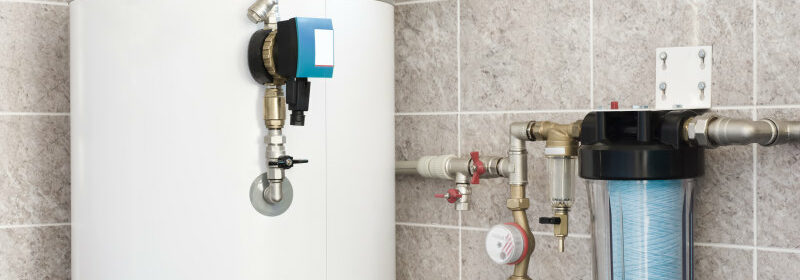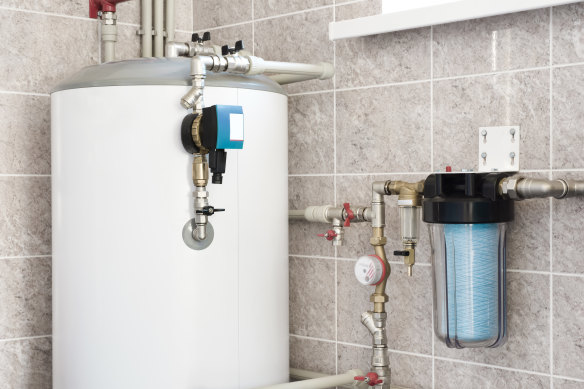How your hot water system could be tweaked to reduce power bills

Save articles for later
Add articles to your saved list and come back to them any time.
Australians could be overlooking a simple tool that could save billions of dollars as they struggle to cut power bills and reduce greenhouse gas emissions – humble electric hot water heaters backed up by smart meters.
A 300-litre hot water tank in a suburban home can store about as much energy as a Tesla Powerwall (which reports say costs upwards of $17,000) at a fraction of the cost, researchers from the UTS Institute for Sustainable Futures have found. Tesla no longer publishes its Powerwall’s price on its website, but it’s reported that it can cost up to $19,000 including installation.
Hot water heating systems could be key to helping Australians reduce their electricity costs.Credit: iStock
The UTS researchers found that if water is heated during the day when the grid is awash with cheap power from solar energy, and the tanks are switched off by smart meters during peak demand, they not only smooth out stress on the grid but could collectively save Australian homeowners between $4.7 and $6.7 billion a year on energy bills by 2040. Published on Monday, the research was funded by the Australian Renewable Energy Agency.
“From the perspective of the overall energy system, switching a fleet of water heaters on and off means you can increase and decrease demand, much like you can with a battery,” lead researcher and UTS Institute for Sustainable Futures director David Roche said.
The agency’s chief executive officer Darren Miller said through the deployment of innovative technology solutions, it could help unlock the potential of domestic hot water systems across Australia.
“As households continue to purchase electric hot water systems, we can look to options to dynamically manage load, ensuring the benefits of renewables are realised at least cost to consumers,” he said.
Tesla’s second-generation Powerwall home battery.
Roche said governments, network operators, supply chain operators and manufacturers, and communities need to work together to ensure that technologies can turn water heaters on and off in response to energy demand.
He added that while it was important to look at how future houses are built and operate, there was a growing problem with ensuring pre-existing homes could also play their part in the energy transition.
“There are things happening in the residential space, but more could always be happening. There are some moves, for example, in the ACT that all new builds must not have gas connections. That is something NSW should be looking at.”
”The other question is what do you do with the existing 10 million homes and how do we improve and electrify them.“
Clean Energy Council director of distributed energy Con Hristodoulidis said that helping households invest in energy efficiency in the home with things like smart hot water systems is cheaper and easier than the challenges facing the industry – such as rebuilding power stations and grids to reduce emissions, or building large-scale battery sites.
However, several factors are slowing down this transition. One of those is that states and territories have different regulations and targets. Hristodoulidis said a national scheme was needed that would help with the smaller-scale transition.
Another is the large upfront cost of installing more energy-efficient and renewable technology, which is negated over time. In some cases, state or federal government incentives help with the cost.
For example, household batteries promise to harness solar energy during the day and provide households with clean and affordable electricity long into the night. A lithium-ion battery can cost between $7000 and $15,000 depending on capacity and model – more than the cost of an electric water heater.
While Australian households’ enthusiasm for batteries has increased steadily over the past few years, it hasn’t grown as quickly as others hoped.
The latest data from solar consulting firm SunWiz shows there has been a 55 per cent growth in solar battery installations since 2021 – with almost every jurisdiction, except South Australia, experiencing record energy storage system installations last year.
SunWiz’s Warwick Johnston said the spike was driven by consumers wanting to be more self-sufficient and resilient following the pandemic and subsequent economic shock, as well as the electricity prices increase.
But he said that while battery installations were increasing, their prices remained high.
“[Battery prices] haven’t really shifted and things look like they may head up with inflation,” he said. “Electric vehicles have grown in such great demand that they have soaked up all available lithium supply and people are much more interested in electric vehicles than home batteries.”
He said as more lithium mines, refineries and manufacturing of batteries come online, battery prices will fall.
But he said national subsidies, or an expansion to the solar panel rebate, would allow batteries and other energy-efficient technologies to become more affordable and accessible for many currently priced out of the market.
Get to the heart of what’s happening with climate change and the environment. Our fortnightly Environment newsletter brings you the news, the issues and the solutions. Sign up here.
Most Viewed in Environment
From our partners
Source: Read Full Article

